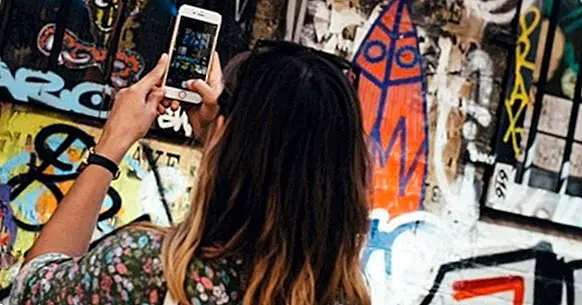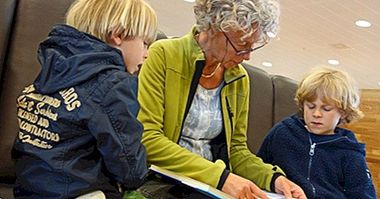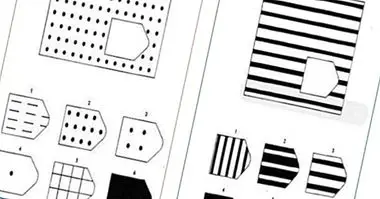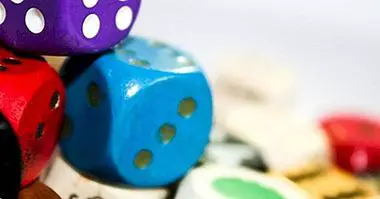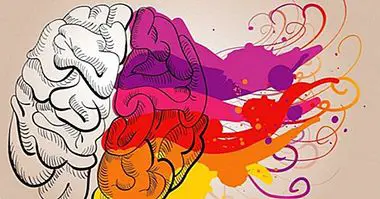Creativity: typologies, dimensions and phases of the creative process
Creativity is a psychological phenomenon of great importance both individually and at a collective level. We need creativity when we seek to solve an everyday problem at an individual level and it is also useful, collectively, in science, in art or in technology.
Any advance of humanity has its origin in a creative idea . In the same way, unfortunately, creativity has been present in most of the most despicable and aberrant situations in the history of mankind. For good and bad, creativity distinguishes us from other beings on this planet, being, perhaps, the most defining characteristic of the human being.
Recommended article: "81 creative phrases to let the imagination fly"
Some integrative proposals to define creativity
The main obstacle to studying creativity at the scientific level is to reach consensus on a definition that will please all those who investigate it from different disciplines. One of the most complete definitions that have been achieved so far is perhaps that of Vernon (1989): “Creativity is the ability of the person to produce new and original ideas , discoveries, restructuring, inventions or artistic objects, which are accepted by experts as valuable elements in the field of science, technology or art. Both originality and utility or value are properties of the creative product even though these properties may vary over time. "
With a rather abstract approach, some authors define it as "Ability to produce new ideas, original and appropriate" (Sternberg and Lubart, 1991). It would be understood by original something that is relatively infrequent, although, it agrees to speak of degrees of originality, rather than to see it as something absolute in the sense of "all or nothing". In terms of whether something (idea or product) is appropriate, it is considered that it is when your proposal solves a significant problem or is a decisive intermediate step to achieve greater achievements. Utility is also a matter of degree.
Creativity as a set of dimensions
Other authors have tried to be more concrete in their definitions, approaching creativity from four levels of analysis. It is what has traditionally been known as 4 P's of creativity .
1. The Process
Creativity understood as a mental process (or set of processes) that results in the production of original and adaptive ideas. It is the perspective adopted by the Cognitive Psychology, which has focused on studying different cognitive operations such as problem solving, imagination, intuition, the use of heuristics (mental strategies) and the insight (spontaneous revelation).
Some theories that have dealt with the different stages of the creative process are inspired by the initial proposal of Wallas (1926). Other authors have devoted themselves to trying to identify the components of creative thinking, such is the case of the studies of Mumford and his colleagues (1991, 1997).
2. The Product (product)
Creativity can be conceptualized as a characteristic of a product , understood as a product of a work of art, a scientific discovery or a technological invention, among others. Generally, a creative product is one that is considered original, that is, it manages to combine novelty, complexity and surprise. In addition, it is adaptive, which means that it is capable of solving some environmental problem. Also, depending on the domain in which it is located, the creative product is related to characteristics such as beauty, truth, elegance and virtuosity, (Runco, 1996).
3. Person (personality)
Here, creativity is understood as a trait, or profile of personality and / or intelligence characteristic of a specific person. It is a quality or individual capacity, so that some individuals have more than others (Barron, 1969).
Individual creativity is one of the objects of study of differential psychology , from where several features that seem to coincide in creative people have been found. Among others, they are: intrinsic motivation (not needing external incentives to create), the breadth of interests (high curiosity in different domains), openness to experience (desire to experiment and high tolerance to failure) and autonomy (Helson , 1972). Currently, personality is understood as one of the influences on creative behavior, and not something that fully explains such behavior (Feist and Barron, 2003).
4. The environment (place or press):
The environment or climate in which creativity emerges is decisive . By combining certain elements of the situation, we manage to facilitate or block the creative process.Creativity usually appears when there are opportunities to explore, when the individual is given independence in his work and the environment fosters originality (Amabile, 1990).
In addition, the environment is key in the assessment of creativity because, ultimately, it will be who determines whether the product can be considered creative or not.
Interaction between creative elements
Evidently, these four elements of creativity are totally related in practice . It is expected that a creative product is generated by a creative person, applying creativity processes, in an environment conducive to the development of such a product and, probably, in an environment prepared for its evaluation. At 4 P's, recently, two new ones have been added, so now we usually talk about the 6 P's of creativity . The fifth P corresponds to Persuasion (Simonton, 1990) and the sixth is the Potential (Runco, 2003).
If we reformulate the question, what is creativity ?, we will obtain, as we have seen, several answers depending on where we put the focus: the person, the product, the process, the environment, persuasion or potentiality. Also, we could refer to the creativity of geniuses, to that of young children, or to that of any person in their daily life, regardless of their age or their genius.
So far, most definitions focus on three defining components or characteristics of the creative fact: the originality that supposes the idea, its quality and its adjustment , that is, how is it appropriate for what it intends to solve. Therefore, it can be said that a creative response is one that is, at the same time, new, appropriate and relevant.

Creativity as a magnitude
Another alternative approach establishes differences between different levels of creativity, addressing it as a magnitude instead of considering it as a set of fixed characteristics. The range of creativity magnitude would range from the lesser or mundane creativity "Little-c" (more subjective) to greater creativity, mature creativity or eminence "Big-C" (more objective).
The first, the worldly creativity, makes mention of the daily individual creativity that any of us uses to solve some problem . It is part of human nature and is materialized in something new for the individual, or for its immediate environment, but it rarely has recognition or supposes a remarkable value at a social level (Richards, 2007). It is a category of great interest in the analysis of influential factors in creativity common at the domestic level, at school or in the workplace (Cropley, 2011).
The second it has to do with the actions and products of eminent individuals in some field . They are those characters that show high performance and / or manage to transform a domain of knowledge or social, for example: Charles Darwin, Newton, Mozart or Luther King.
Mini-c and Pro-c
If we consider the magnitude of creativity as something dichotomous (white or black), we will find the problem of not being able to identify nuances that occur between the Little-c category and the Big-C . That is to say, to speak of two types of creativity, mundane or eminent, does not represent the real distribution of the characteristic in the population because between both a range of possibilities is extended. To try to overcome the limitations of dichotomous categorization, Beghetto and Kaufman (2009) propose to include two new categories, Mini-c and Pro-c, thus expanding to four the categories that would attempt to frame the phenomenon of creativity.
The Mini-c creativity is the most subjective form of all creativity classes. It refers to the new knowledge acquired by an individual and how he internally interprets his personal experiences. In research, it is useful to understand the personal aspects and the development of creativity, helping to explain it in young children.
The Pro-c category represents a level of evolution and effort that begins in the Little-c but it does not become the Big-C, helping to understand the area that extends between both. It corresponds to creativity related to expertise in a professional area. It should be noted that not all expert professionals in an area achieve this type of creativity. Those who achieve it require approximately 10 years of preparation in their domain to become "experts". To become Pro, we will need to prepare a cocktail that contains high doses of knowledge, motivation and performance.
Creativity as a continuum
Although with four categories we can better cover the phenomenon of creativity, they are still scarce to capture its complex nature. Therefore, some authors prefer to treat creativity as a continuum.
Cohen (2011) proposes his "continuum of adaptive creative behaviors". This author considers the interaction between the person and the environment fundamental, from an adaptive perspective , to analyze creativity. His continuum ranges from creativity in young children, to the creativity of eminent adults, establishing seven levels or stages.It proposes some influential variables for the development of creativity along the continuum, such as: purpose, novelty, value, speed and structure.
The mentioned works are only a brief sample of the effort made, especially since 1950, to define creativity from multiple spheres of knowledge, although here we have focused on works in the field of psychology.
Among all the disciplines we are setting certain points according to the time to establish what can be understood by creativity and what is not, although, we are still on the way to decipher the enigma and establish some truth about this phenomenon, which will hardly reach to be absolute, as often happens with many other constructs in the field of social sciences, but that will help us to understand a little better the world around us and our own inner world .
Bibliographic references:
- Amabile, T. M. (1990). Within you, without you: The social psychology of creativity, and beyond. In M. A. Runco, & R. S. Albert (Edits.), Theories of creativity (pp. 61-91). Newbury Park, CA: Sage.
- Barron, F. (1969). Creative person and creative process. New York: Holt, Rinehart & Winston.
- Beghetto, R. A., & Kaufman, J. C. (2009). Intellectual estuaries: Connecting learning and creativity in programs of advanced academics. Journal of Advanced Academics (20), 296-324.
- Cohen, L. M. (2011). Adaptation, adaptiveness, and creativity. In M. A. Runco, & S. R. Pritzker (Edits.), Encyclopedia of Creativity (2nd ed., Pp. 9-17). London: Elseiver.
- Cropley, A. J. (2011). Definitions of creativity. In Encyclopedia of Creativity (pages 358-369). London: Elsevier.
- Feist, G. J., & Barron, F. X. (2003). Predicting creativity from early to late adulthood: Intellect, potential and personality. Journal of research in personality.
- Helson, R. (1972). Personality of women with imaginative and artistic interests: The role of maculinity, originality, and other characteristics in their creativity. Journal of creative Behavior.
- Mumford, M. D., Baughman, W. A., Maher, M. A., Costanza, D. P., & Supinski, E. P. (1997). Process-based measures of creative problem solving skills: IV. Category combination. Creativity Research Journal.
- Mumford, M.D., Mobley, M.I., Uhlman, C.E., Reiter-Palmon, R., & Doares, L.M. (1991). Process analytic models of creative capabilities. Creativity Research Journal.
- Richards, R. (2007). Everyday creativity and new views of human nature: Psychological, social, and spiritual perspectives. American Psychological Association. Washington, DC.
- Runco, M. A. (2003). Education for creative potential. Scandinavian Journal of Education.
- Runco, M. A. (1996). Personal creativity: Definition and developmental issues. New Directions for Child development.
- Simonton, D. K. (1990). History, chemistry, psychology, and genius: An intellectual autobiography of historiometry. In M. A. Runco, & R. S. Albert (Edits.), Theories of creativity. Newbury Park, CA: Sage.
- Sternberg, R. J., & Lubart, T. I. (1991). An investment theory of creativity and its development. Human Development, 34 (1).
- Vernon, P. (1989). The nature-nurture problem in creativity. In J. A. Glober, R. Ronning, & C. R. Reynols (Edits.), Handbook of creativity. New York: Plenum.
- Wallas, G. (1926). The art of thought. New York: Harcourt Brace and World.

